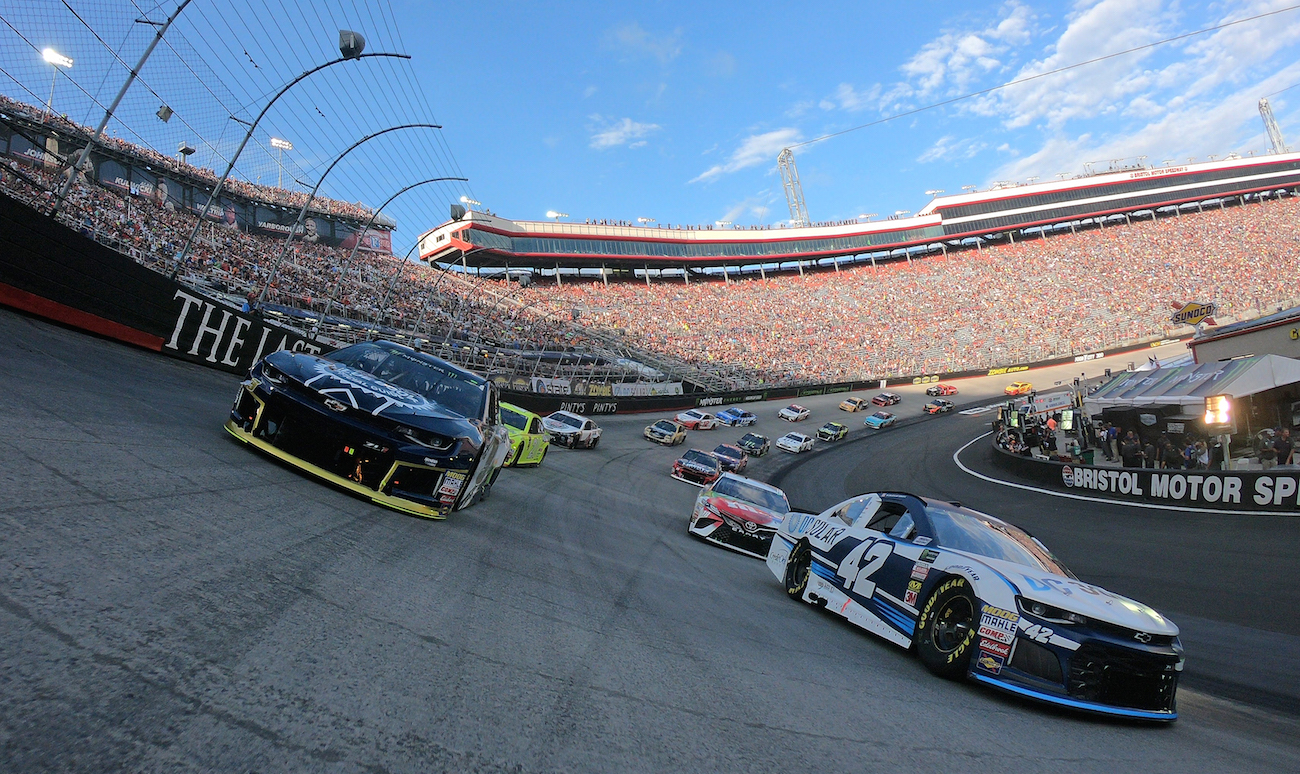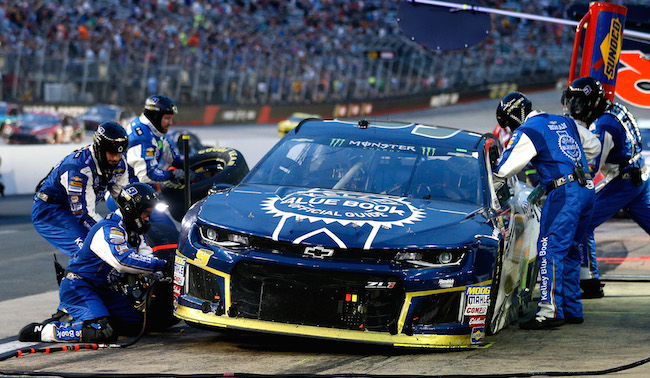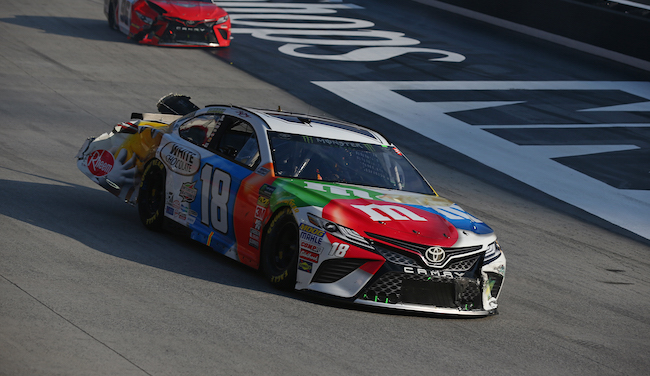
BRISTOL, TN — Within 30 seconds of walking out of the tunnel and into the infield of Bristol Motor Speedway I find myself dodging the first of many cars of the weekend. The half-mile oval is one of the last true short tracks on the NASCAR schedule, as the sport is dominated by mile and a half and larger tracks where infield space is at far less of a premium, providing ample room for RVs and campers.
Bristol is very different — in so many wonderful ways — but the contrast in the infield experience at Bristol to a larger track is rather incredible. Wandering around at a place like Indianapolis, it takes serious effort to be in the way of the teams and crews at work. At Bristol, it’s impossible not to be in the way, even if you’re actively trying not to be. There are no garages, only the team trailers crammed in side-by-side with about a person’s width between them.
Your hot pass guarantees you close encounters with cars, drivers, pit crew members, and safety crew vehicles. “Rubbin’s racin'” is never more appropriate than at Bristol, where close quarters lead to constant contract on and off the track.
After dodging cars, toolboxes, hand carts full of tires, and golf carts for the better part of 24 hours, I finally am unable to avoid contact at Bristol. During driver introductions, while standing in pit lane near Chase Elliot’s Kelley Blue Book No. 9, Kyle Busch delivers a forearm shiver to my back while pushing his way to his No. 18 M&M’s machine, setting the tone for the evening as Busch would find himself in three on-track wrecks while somehow managing to finish 19th despite losing his rear bumper less than 10 laps into the race.
Bristol calls itself “The Last Great Colosseum” of racing. It’s a throwback to when short tracks were more prevalent and its nickname is a nod to its status as a true racing stadium, fully enclosed by stands, which makes it stand out compared to spread out superspeedways. The infield experience is a jumbled, congested mess, but an enjoyable one, much like races at Bristol themselves.
Luck is as big a factor at Bristol as anywhere in NASCAR, where simply being at the wrong place at the wrong time when rubbin’ becomes wreckin’ can end your day. However, it also allows drivers to tap into their roots. Short tracks are where drivers honed their craft because there aren’t many local 1.5 to 2.5 mile tracks. A half-mile track evokes a certain nostalgia for drivers to their younger days, even those that grew up with rich NASCAR ties.

Chase Elliott entered Bristol a week after picking up his first win at Watkins Glen, going from a road course that is among the longest on the NASCAR Monster Energy Cup Series circuit, to a track that’s tied for its shortest. Elliott reveled in the opportunity to get to a short-track, as he lit up as we spoke prior to the race about his racing history outside of NASCAR, most notably at the Snowball Derby at Five Flags Speedway in Pensacola, Florida.
“My favorite non-Cup win probably has to be one of the Snowball Derby wins,” Elliott said. “It’s a big short-track race down in Pensacola and I felt like our success down there racing super late models kinda led to where I’m at today and offered up some opportunities. So those are really important days and important years of racing that opened the eyes of some people that ultimately led to where we are now.
“I love short track racing,” Elliott adds. “I wish we did more of it. There’s really only two short track races on our schedule at here and Martinsville. It’s a shame we can’t find a way to go race more short tracks because places like this are just second to none with how much fun they are to drive and so, so refreshing to come to a race track and go out there and feel like you really have to be perfect to be successful and put up a good lap. You feel [as a driver] like you make a bigger difference here than other places, which I think is really cool as a driver and keeps some integrity in what we do.”
There are only two half-milers that NASCAR still runs — Bristol and Martinsville, where they will be on Oct. 28 — along with one three-quarter mile track at Richmond. Having only four or six of the 37 races on the Cup Series schedule being short tracks (depending on the definition) means there aren’t a ton of opportunities to show off short track prowess, where mistakes are magnified on the track and in the pits.
Elliott wishes NASCAR would venture out to short tracks more often, both for the test it gives the drivers and because short tracks offer the best fan experience in the sport.
“Every time people ask me what races to go to, I feel like the Bristol Night Race is either at the top of the list or really close,” Elliott said. “So, when you recommend that to someone it obviously means it’s special, and it would be pretty cool to have a good run at the Night Race. It’s a cool atmosphere, a cool venue, and just a place that’s an awesome place to watch an event.”
A typical race at a longer track has its lulls as the race settles into a rhythm — a constant criticism of NASCAR from detractors of the sport — where the race will go on lengthy green flag runs with little in the way of drama. NASCAR has combatted that at the superspeedway level — 2.5 mile tracks like Daytona and Talladega — by making them restrictor plate races, which lessen the gap between the best teams and the smaller teams by restricting the amount of power an engine can put out and thus leveling out the playing field. Restrictor plates have been controversial with fans and drivers since their implementation, but there’s no doubt they’ve worked in terms of creating the pack racing and more constant drama at those tracks.
Short tracks, however, don’t require any extra effort to create that constant drama, as there’s no room for the field to get strung out. If a car is faster and a driver is more skilled at navigating their way around, they’ll simply lap cars, but there’s always drama. Short track racing requires constant vigilance from drivers to recognize when they’re approaching lap traffic and ensuring they’re set up to make the pass smoothly. If they make an error in judgment and get caught up in lap traffic, they’ll get slowed up and passed themselves.
“It’s definitely different, and it’s very busy,” Elliott said. “As you get running along in this race, hopefully you’re fast enough to where you’re catching other cars and you’re putting people a lap down, and if that’s the case you really gotta be on it to hit lap traffic right. Because if you hit lap traffic in the wrong place and the guy behind you doesn’t you can really get taken advantage of there and vice versa. You want to be the guy doing the overtaking and trying to take advantage of them. And honestly, sometimes there’s nothing I can do or the spotter can do to keep you out of those bad situations. It’s just timing and how you catch ’em, and what you do when you get there without crashing. So, it’s a fine line and it’s pretty chaotic. The heart rate’s up and you gotta find your way through them fast or the guy behind you’s going to catch you.”
It’s a 500-mile cat and mouse game, which means even in a long green flag run — of which there aren’t many given the close quarters and regular contact — there’s plenty of action on the track to keep the fans in attendance and watching at home hooked.

Short tracks also can reveal a lot about the drivers and their personalities in the way they handle the stress of short track racing. Kyle Busch, who has swept all three races at Bristol, attacks with brute force and undeniable skill, weaving through traffic, creating contact, and taking risks few others would even dream of considering. That can create spectacular results, both good and bad, as evidenced by his outing on this night. The first wreck isn’t of his doing, but from there he presses to get back despite being down two laps. He makes some jaw-dropping moves to slip between two cars at a track where going three-wide is almost unthinkable. He also loses patience and turns Martin Truex Jr. into the wall, before wrecking for a third time after a tire rub from earlier contact causes him to get a flat and spin out himself.
On the flip side, Elliott wheels the Kelley Blue Book Chevy to third place with nary a scratch to be found after the race. He’s calculated and patient, positioning himself to be in the right place at the right time, every time, making slick moves when necessary and attacking with confidence when an opportunity to move up presents itself. The best example of Elliott’s calculated nature comes on pit road, where on one occasion he slams on his brakes near the end of pit road to allow a car to pass him to ensure he restarts fourth instead of third.
At most tracks, that’d be an incredibly curious choice, but on this night at Bristol, it’s a savvy move. The outside lane has been the best, by far, on restarts, and while the first place car can choose its lane, the rest go in order, odd spots on the inside, even spots on the outside. Slipping to fourth allows him to line up behind the first place car and roar into second immediately, as the outside lane freight trains the inside once again.
Elliott led 112 of the 500 laps on the evening, the third most of anyone in the race, but a bit of a rough final pit stop pushes him too far back to make up the ground on eventual winner Kurt Busch. Again, those are the margins at Bristol.
NASCAR isn’t dying as many would suggest, but it has plateaued in popularity. There are constant debates about how the sport can connect with a younger audience, which is not a unique situation in the world of sports and entertainment. Almost universally the consensus when it comes to engaging with today’s audience is to get shorter. Television and entertainment companies are all in the business of producing short videos, meant to keep the attention of the viewer for the entirety rather than having their interest fade and turn elsewhere.
Many have pointed out that NASCAR’s commitment to tradition is part of their problem, that the sport doesn’t encourage enough personality from their drivers, and that the “good ol’ boy” image that has dominated the sport doesn’t connect with younger people today. That may be the case, but leaning on its short track roots might be the perfect meld of old and new. Going shorter is the answer most industries have come up with, and in NASCAR the same formula yields similar results.
Short tracks like Bristol and Martinsville offer more captivating races for their entirety. They hold your attention because there is constant conflict and the stakes are so high for every mistake made. It makes for better TV, as there’s always action to cut to. It makes for a better live experience as well as you can see every bit of the action no matter where it is on the track from most vantage points. You just have to keep your head on a swivel and avoid contact, particularly if Kyle Busch is near.
Kelley Blue Book provided travel accommodations for this story. You can read more about our policy on press trips and hostings here.






